I decided to check out the new East 180th Street subway stop on the White Plains/Dyre Avenue Line (#2/#5 lines in the Bronx — after a couple of years’ construction, the station was finally done, on the platforms, in the fare control/waiting area and on the exterior. It’s one of the most sumptuous, voluminous subway stops in the entire system — the Bronx’ answer to the old Penn Station. I’ll explain why in a bit.
The new East 180th Street platform won’t win any beauty contests — it’s purely utilitarian, though it has been decked out with retro-style light stanchions, which have increasingly been seen on elevated train platforms around town, a welcome development. If you rode north on the Dyre Avenue branch, most often the #5 train, you would skirt the IRT subway yard located just north of here and then descend onto an embankment, which goes into an open cut, into a tunnel and finally an elevated at its northern end going toward Dyre Avenue. In 1940, the IRT took it over from the defunct New York, Westchester and Boston RR.
The new platform also added brand new light fixtures to the station canopy (rain protector). There’s a nice view west on East 180th and in the distance, the tall spire of the Beck Memorial Presbyterian Church on Vyse Avenue can be spotted.
The entire interior of the station house — one of the largest in the NYC subway system — was remodeled and given new mosaic signs and station art (“Station Villa” by Luisa Caldwell). New storefronts have appeared just inside the entrance, but as of this writing no new tenants had moved in. Note that girders and pillars holding up the elevated trestle have been kept in view and given new paint jobs. New pendant lighting has been installed as well.

Unfortunately I don’t have any photos of the interior of this space before its 2011 renovation. The reason for that is simple — this was formerly the headquarters of the NYPD Transit District #12. Now, the police feel about subway photographers about the same way that stadium security feels about streakers. In fact, a few years ago at one of the stations along the Dyre Avenue branch, a couple of NYPD made me delete my camera photos after catching me taking pictures of the platform area. This was before a memo went out to officers that non-tripod photography is legal. (In fact a court made yet another ruling on this in March 2013, just a few months before I began writing this page). However the NYPD has been known to ignore the ruling, forcing photographers to go to court to get their cases thrown out.
The NYPD has since moved to a new building across Morris Park Avenue, and MTA offices now occupy the bulk of the station house.
The restored exterior of the East 180th Street station. It was built as one of the flagship stations of the NYW&B and still looks as if it ought to be the hub of a railway serving NYC, Westchester and New England. Perhaps in the future — right now, it’s just another local stop, albeit one that serves two branches, one that runs almost to the city line at Mount Vernon in Wakefield, and another that runs to Dyre Avenue.
Besides the already-noted updates, a clock has been restored to its position just below Mercury, the Roman messenger god who was a symbol of the NYW&B. Decorative medallion have also been restored, including one showing an oak tree and leaves as well as two cornucopiae, symbols of abundance.
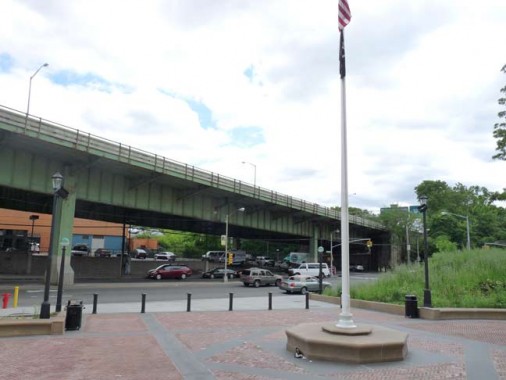
The plaza in front of the station house faces East 180th Street at Morris Park Avenue; the Bronx River Parkway passes overhead.
WAYFARING MAP: MORRIS PARK TO WEST FARMS/CROTONA EAST
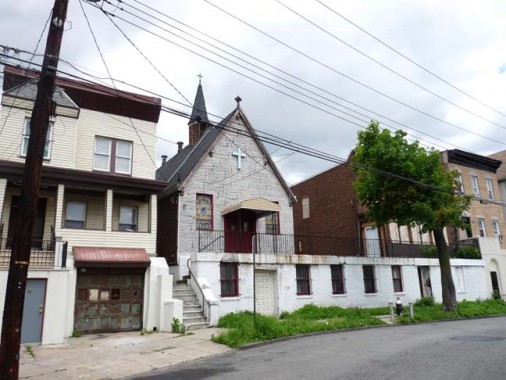
Many areas in NYC that have street names instead of numbers have naming schemes. For example, in Staten Island, there are neighborhoods with only classical composers (Beethoven, Mendelssohn) and astronauts (Grissom, Shepard). The Bronx has number of them — in Eastchester all the names are 19th Century NYC mayors. In southern Morris Park, we find US Presidents — John Adams, Martin Van Buren, Zachary Taylor, James Garfield, and Millard Fillmore — as if to give the not so well-known Presidents a chance. I’ll include Adams in that group because, despite being one of the key founding fathers, his image never wound up on any currency until the dollar coin issued a few years ago.
(Amid the Presidents here is Melville Street, and even the late great Bronx historian John McNamara was unsure it honors the great author buried in Woodlawn Cemetery.)
I went up Adams Street, which has a slight bend, and there’s a church at the bend in the road at #1722 that’s unusual in that it’s completely unmarked, except for the cross and steeple. Poking around a bit in the internet revealed it to be St. Luke’s Evangelical Lutheran Church.

More surprising was the church in what was probably once a multifamily residence at 475 Van Nest Avenue at Adams, billing itself the Love Gospel Church.
(Despite the title card I know I’m in the Van Nest neighborhood, not Morris Park proper. I was on Morris Park Avenue, though, once I left the station.)
Van Nest is an old name and comes from Dutch colonial settler Pieter Pietersen Van Neste, who arrived in North America from Holland in 1647. However, the family is only honored here because of the Van Nest Land & Improvement Company, which began developing the neighborhood in 1892. Scions of the Van Nests became railroad company directors and developers but according to McNamara, no Van Nest actually lived in the Bronx.

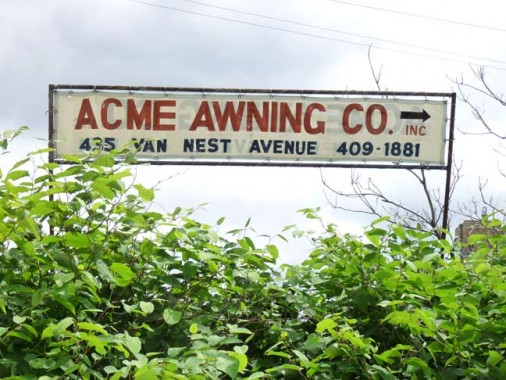
Though Van Nest Avenue is a major artery in the Van Nest neighborhood, paralleling Morris Park Avenue, it trickles to a dead end at Amtrak tracks south of East Tremont Avenue, though you will find the place where Wile E. Coyote goes for his window shade needs.
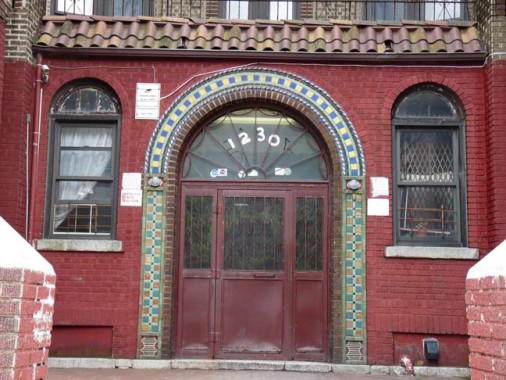
Tremont Avenue, East and West, runs from the Harlem River to the East River east and southeast. It was formed from a number of different roads and united under one name during the 19th Century.
Though Van Nest is one of the Bronx’ poorest neighborhoods, there’s this terra cotta-decorated apartment building at #1230 near the Bronx River Parkway overpass, patiently waiting its turn till the forces of gentrification find their way here. I found more apartment building surprises (see below).
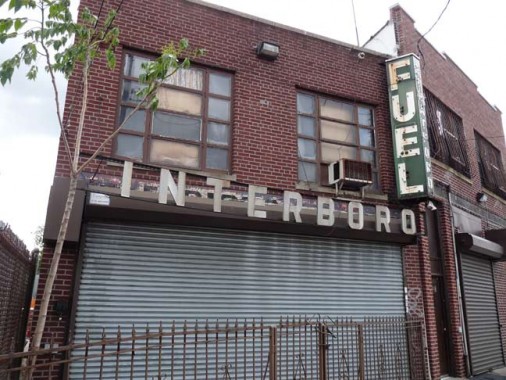
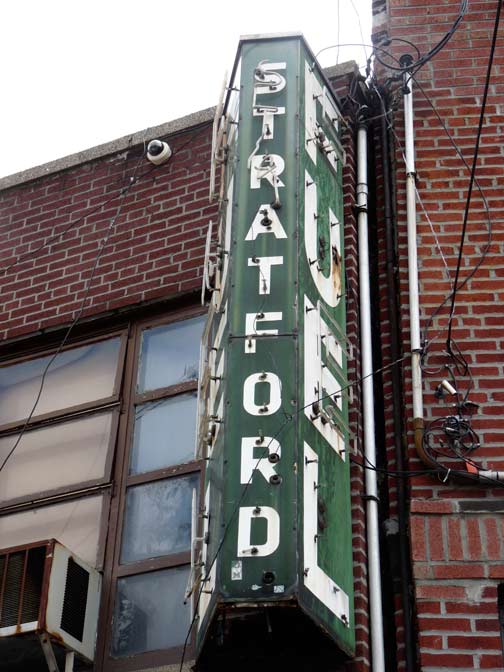
Don’t know if Interboro Fuel, or Stratford Fuel, is still a going concern but it has not just a wrought metal sign but also a vertical once-neon sign — very impressive.
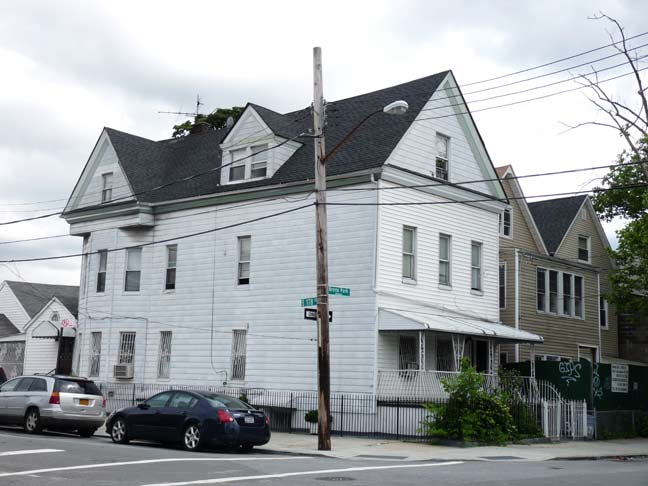
There’s a little grid of streets south of East Tremont and west of the BRP, cut off by the Bronx River, Sheridan Expressway, and Cross-Bronx Expressway. Here old architecture persists, and secrets and whispers of times long ago must also survive as well, perhaps only as memories of the old timers. What has this old veteran at Bronx Park Avenue and East 178th seen and heard?
The avenue was opened in 1887 ands runs north to the east end of the park for which it was named.
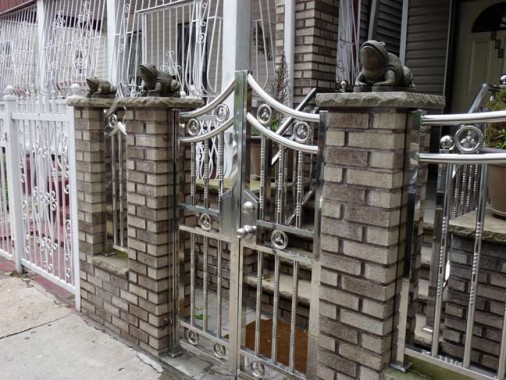
In today’s Bronx, some homeowners choose to imprison themselves as a necessary protection against miscreants. Some Bronx Park Avenue frogs croak at the passing parade.
At Wyatt Street and Devoe Avenue is a handsome, pitch-roofed, Ionic-columned post office built in 1935, likely under the auspices of the Works Progress Administration.
A look at the cornerstone reveals that Mott Haven’s distinctive post office was built in 1935 when Henry Morgenthau was Secretary of the Treasury and James Farley was Postmaster General.
After 1937, while still in charge of the Treasury, he played the central role in financing US participation in World War II. He also played an increasingly major role in shaping foreign policy, especially with respect to Morgenthau Plan) preventing Germany from ever again being a military threat. His son Robert Morgenthau was the longtime District Attorney for Manhattan from 1975-2009.
James Aloysius Farley was one of the first Irish Catholic politicians in American history to achieve success on a national level, serving as Chairman of the New York State Democratic Committee, Chairman of the Democratic National Committee and as Postmaster General simultaneously under the first two administrations of President Franklin D. Roosevelt. He was one of the first Roman Catholics to achieve national success; Al Smith had run unsuccessfully for President in 1928. He was a champion of civil rights in the 1920s, as Chairman of the New York State Athletic Commission, he unsuccessfully tried to integrate boxing, as after Jack Johnson’s success, promoters colluded to keep African-Americans from challenging for titles. Later, he was CEO of Coca-Cola and helped spread the brand worldwide. –adapted from wikipedia
The main branch of the post office in Manhattan at 8th Avenue and 33rd Street is named for him. There has been talk for many years about making it the new Penn Station Building (Sen. Daniel P. Moynihan urged the project and whenever anything is done it will be renamed the Daniel P. Moynihan Station).
The real surprise in the neighborhood for me, though, was this relatively undistinguished-looking residential building at East Tremont and Devoe. By every entrance there are a pair of stone lions guarding a decorative fountain.
Were all these fountains purely decorative, or were they actual fountains? In either case were they constantly replenished with water? Today they sit empty, or are filled with stagnant rainwater — making them an excellent breeding ground for discerning mosquitoes — or are filled with garbage.
The lions know but they aren’t talking.
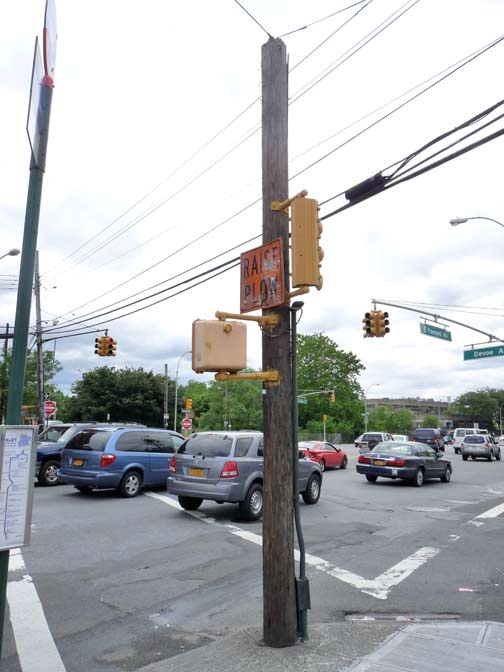
A cut-off telephone pole on the opposite corner makes a dandy place to hang stoplights, pedestrian control signals and other signs. No pole surface in NYC stays empty for long. If the city doesn’t use it, various businesses hang signs on them, and politicians the same in campaign season even though the practice is officially illegal.
The ‘Raise Plow’ sign indicates there was roadwork here and that trucks with snowplows should raise them for safety’s sake.


East Tremont Avenue crosses a bridge whose walkway is protected by a wire screen. Most motorists never notice that they are passing over the swiftly rushing Bronx River, said by many urban naturalists to be the only true river located in the city, though there are smaller brooks and streams in the Bronx.
Nature (with human assistance such as the Bronx River Alliance) has reclaimed several sections of the Bronx River from the industrialization it had been subjected to beginning in the early 1800s.
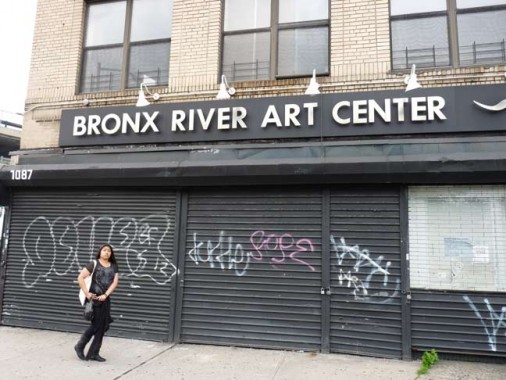
Bronx River Art Center (BRAC) was founded in 1987 to bring professional arts programming to a culturally underserved population. For more than twenty years (including several years of arts programming under the umbrella of the first Bronx River Restoration project), this multi-arts center has filled the West Farms community of the Bronx with art and environmental experiences. Our programs are designed to encourage our residents to engage in creative activism towards the revitalization and future of their neighborhood. BRAC
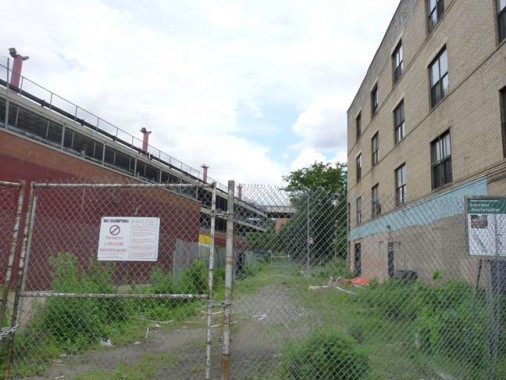
There are two streets in The Bronx named for the borough (and unaccompanied by any other word, like Park or River): Bronx Boulevard, in Williamsbridge and Wakefield, and the forgotten and abandoned Bronx Street on East Tremont Avenue just west of the river.
Elsewhere, Manhattan has Manhattan Avenue, Queens has Queens Boulevard, Queens Plaza, Queens Street and even Queens Walk in Breezy Point; Brooklyn has Brooklyn Avenue and Staten Island the Staten Island Expressway and the short Staten Island Boulevard in Emerson Hill (though most of its major roads have Richmond in the names).
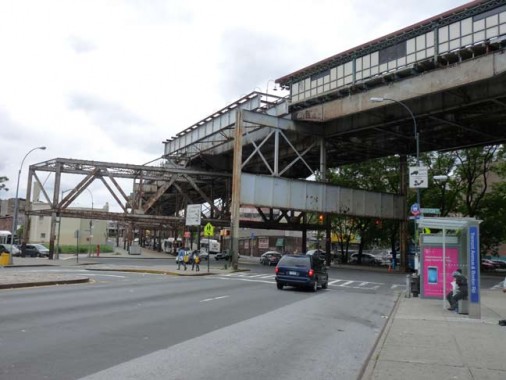
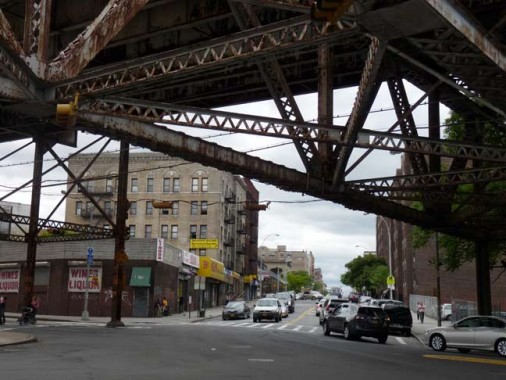
If a road in NYC is long enough, eventually an elevated train will find it and shadow it for at least a few blocks. Even Broadway itself isn’t immune, as the #1 train finds it in upper Inwood and runs above it to Van Cortlandt Park.
In West Farms, the White Plains Road line (#2, #5) is transferred from Southern Boulevard to Boston Road at East 174th and follows it to West Farms Square, where it runs through the IRT yards and Birchall Avenue until finding White Plains Road near Pelham Parkway.
Here Tremont Avenue gains, or loses, a couple of lanes, depending on where you are heading.
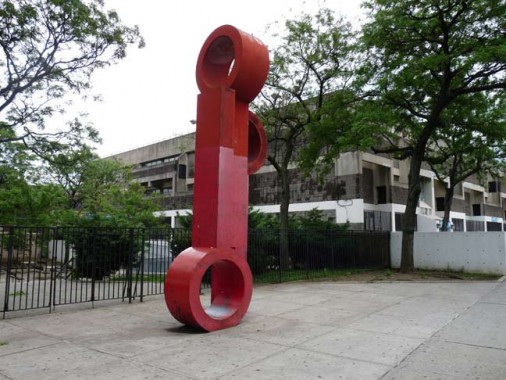
Artwork (perhaps a closer look at the object might reveal the artist) at the Lorraine Hansberry Academy (PS 214) on West Farms Road near East Tremont. It reminds me of a pair of stylized handcuffs.
Hansberry (1930-1965) wrote the play A Raisin in the Sun, which was performed on Broadway and became a motion picture starring Sidney Poitier.
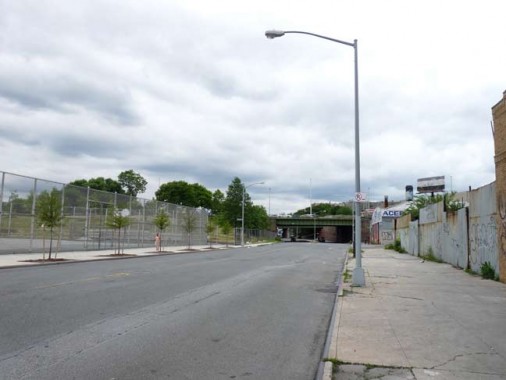
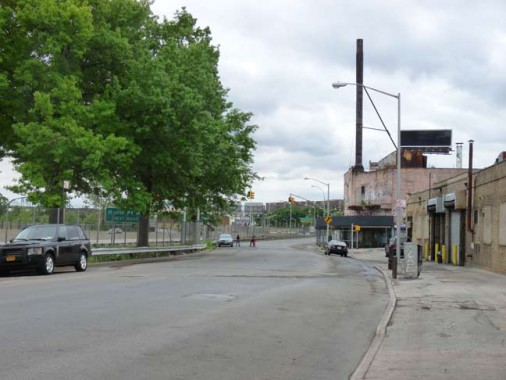
WEST FARMS ROAD
West Farms Road runs a twisting, turning route from Gladstone Square, at Southern Boulevard and Westchester Avenue, north to West Farms Square at Boston Road and East Tremont Avenue. For much of its present-day route it runs alongside the Sheridan Expressway, which opened in 1963. West Farms Road is much older than that, though. Before the expressway was constructed it ran along the Bronx River:
(Click on the above Gallery for a closer look)
We see in this Bromley atlas from 1923 that the road ran along the river, but its twists and turns don’t correspond to those of the river, so I’ve always wondered why it wasn’t straight. Perhaps it was done that way to reduce the effects of hills on carts and wagons.
John McNamara says it follows a Native American trail along the river, and has been mentioned in colonial-era journals going back to 1723. It has been called the Lower Road, the Back Road, the Queen’s Road and Hive Town Road. It could be a contemporary of the old Albany and Boston Post Roads, pieces of which can still be found in the Bronx. In 1802 it was given the name West Farms Turnpike.
The town of West Farms was once a busy portside hub in the pre-Civil War era. The Bronx River was once navigable for East River shipping this far north. It was called West Farms simply because a number of local farms were west of the river.
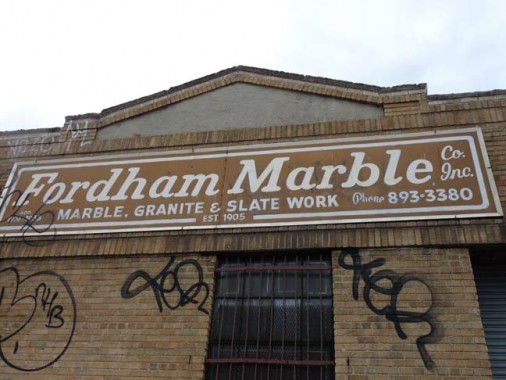
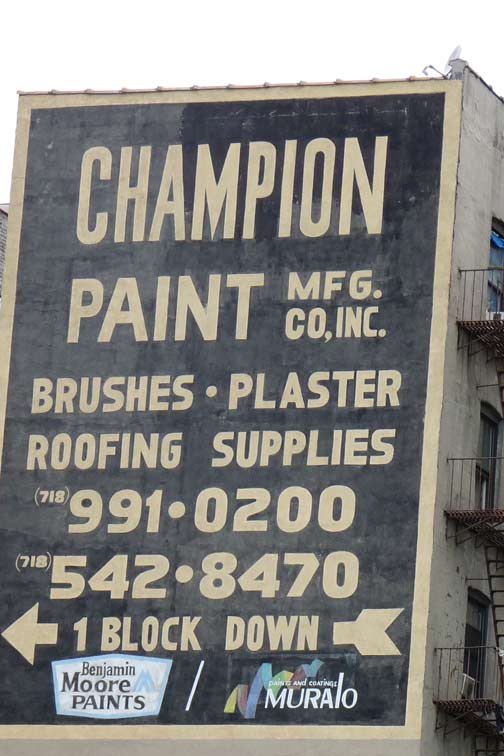
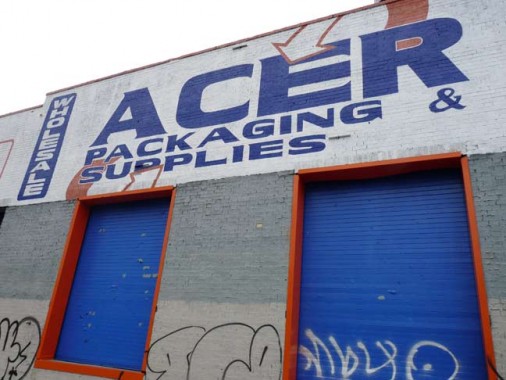
Probably by coincidence, West Farms Road has become something of a mecca for the hand-lettered painted sign, as well as the art of the “wall dog,” the sign painter and letterer on the sides of taller buildings. With the advent of computerized printing, the wall dog doesn’t get as much work anymore — but his works are always distinctive.
A handsome truss bridge crosses the Bronx River, connecting East 174th Street with Crotona Park East and Soundview. A look at the plaque on the west riverside –which motorists can’t safely do — reveals it was constructed in 1928 during the Jimmy Walker mayoral administration.
Bridges NYC has a good history of the span:
The East 174th Street Bridge carries four lanes of vehicular traffic and two pedestrian sidewalks across the Bronx River and the railroad tracks of Amtrak and CSX in the West Farms section of the Bronx. It has a total length of 589 feet, with a main through truss span of 190 feet, and has a vertical clearance of 30.5 feet.
A bridge across the Bronx River at East 174th Street was in demand for years before it was built. In 1910, six tracks ran just east of the river, operated by the New York, New Haven and Hartford Railroad. That year, the railroad agreed to build bridges over all street crossings. A span was erected at East 174th Street, but only over the tracks. In subsequent years the New York, Westchester and Boston Railway also began using the tracks. Disputes between the railroads and the city over who should pay for the rest of the bridge ensued, and no river crossing or approaches to it were built. By 1918, the finishing of the bridge was considered long overdue, and Bronx property owners requested that the Public Service Commission build the bridge.
By 1925, due to efforts by the Bronx Board of Trade, a proposal for the bridge had been accepted, and plots of land around it started to be bought up. In January 1927, the Board of Estimate finally appropriated $340,000 for the construction of the bridge.

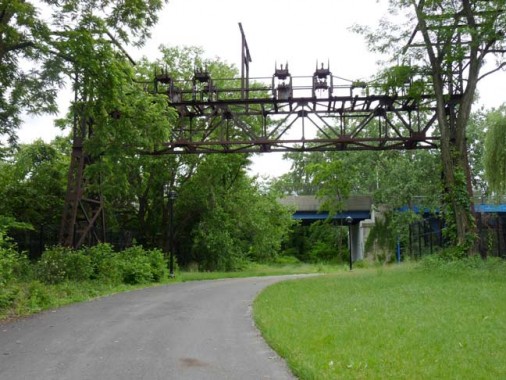
The bridge has ramps that connect to the relatively new Starlight Park, a marvelously rebuilt riverside park that combines almost rural or suburban scenes along with the Bronx River with no longer used relics of the NY, New Haven and Hartford Railroad New York, Westchester & Boston RR.
I’ll make a confession here. Since I intend to include Starlight Park in an upcoming ebook, I’ll hold off declaiming its history and showing more of the many photos I took of this Bronx oasis.
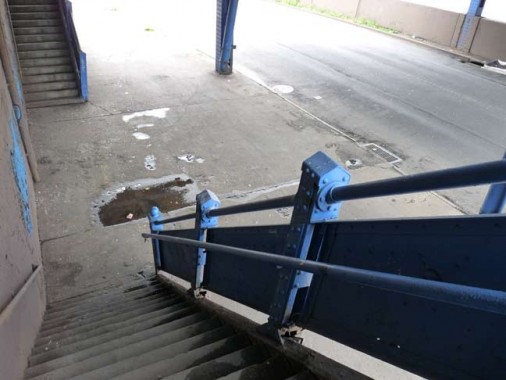
A reminder that we’re still in the Bronx are the staircases from West Farms Road to the bridge. You need to use these to get from West Farms Road to Starlight Park, and they’re the weak link in the overall experience. They seem to be a muggers’ haven and of course, stinking of urine.
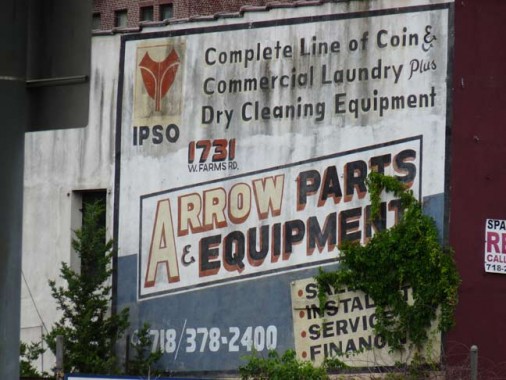
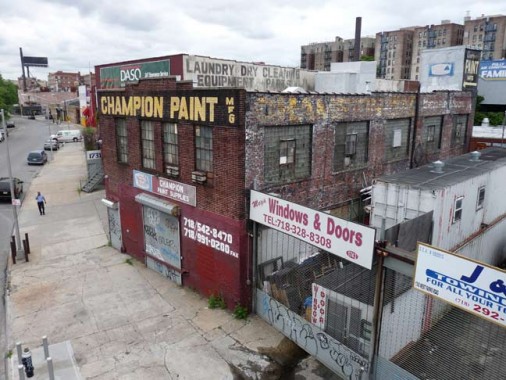
More handlettered painted signs along West Farms Road. This is the Champion Paint the other sign was pointing toward. Note the older sign for laundry equipment on the roof.
“Arrow” is used in a number of businesses, including the old Arrow Collar Company and a forgotten (except by me) line of street maps.

At East 173rd and West Farms Road, this reminded me of a character from Marvel Comics…
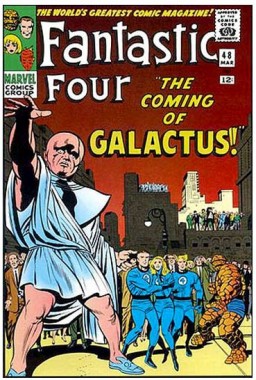 The Watchers are one of the oldest species in the universe, and are committed to observing and compiling knowledge on all aspects of the universe. This policy of total non-interference came into existence due to a former, well-meant attempt by the Watchers to bestow advanced knowledge on the Prosilicans who used the nuclear technology gained to create weapons and destroy itself…
The Watchers are one of the oldest species in the universe, and are committed to observing and compiling knowledge on all aspects of the universe. This policy of total non-interference came into existence due to a former, well-meant attempt by the Watchers to bestow advanced knowledge on the Prosilicans who used the nuclear technology gained to create weapons and destroy itself…
Despite this, the Watcher Uatu has revealed himself to the superhero team the Fantastic Four, telling them of his race, and in his first appearance made them battle the Red Ghost and his Super-Apes for control of the Moon. He complimented Reed Richards, and claimed he would go to a more distant part of the Galaxy to observe humanity. He aids them on several occasions against global threats such as the Molecule Man, Galactus, and the Overmind… wikipedia
Seems to me the Bronx could use these guys.
A block west of West Farms Road, from East 172nd-173rd Streets, is Boone Avenue. Some local artists have covered the walls on the east side of the avenue with art, making it look like a mini-5 Pointz.
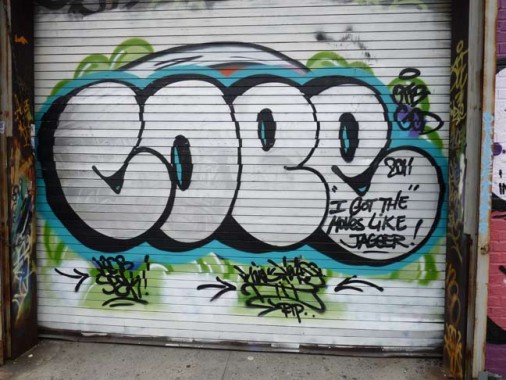
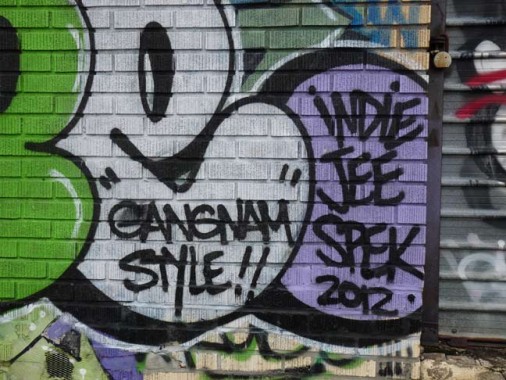
Some less talented taggers appear on the west side of the avenue. Trying too hard with 2012 pop hits — will mean nothing in 5-10 years, except as possible touchstones of an era.
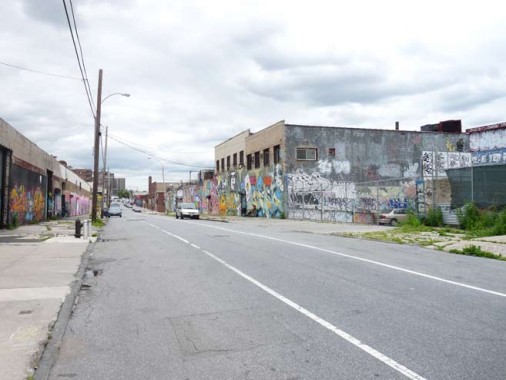
Boone Avenue was named in 1904 for a previous resident, John Bones, and not for the backwoodsman/frontiersman Daniel Boone.
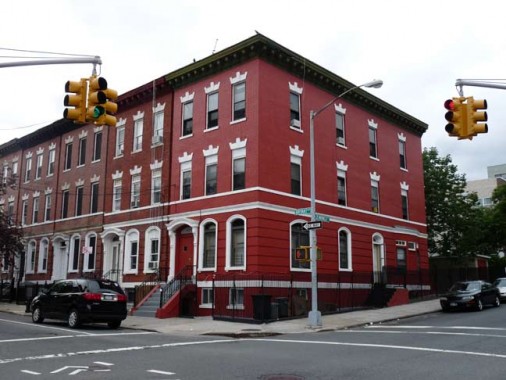
Coincidentally the east-west Jennings Street intersects with Bryant Avenue (named for journalist William Cullen Bryant) and “Jennings-Bryant” sounds like William Jennings Bryan, who was nominated for president four times by the Democratic Party in the late 19th and early 20th Centuries.
Jennings Street takes the place of 171st on maps, and is one of a trio of east-west named streets, along with Home and Freeman, that run through the Crotona Park East area.
This is one of the handsome brick apartment buildings found in the area.
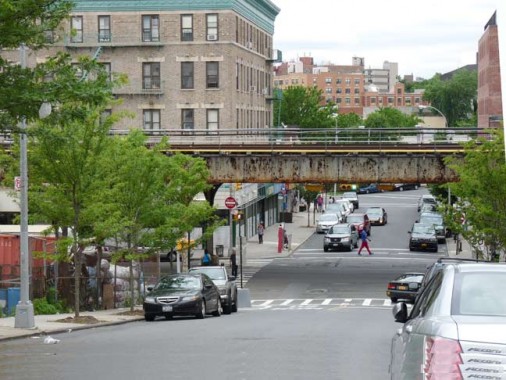
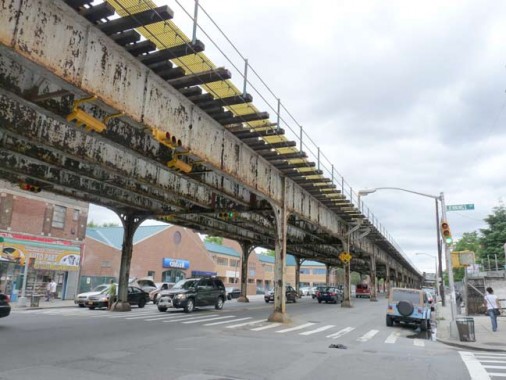
Southern Boulevard, and the el that sits on top of it, were laid out in a valley just west of the high elevation near the Bronx River. The el was pushed through as far north as West Farms Square in November 1904, making these among the older tracks still in regular use that connect to the IRT subway, which opened the same year. From the looks of things the el hasn’t had a paint job since 1904. Metal structures tend to rust and fall apart when not painted, but I imagine the MTA knows what it’s doing.
Southern Boulevard was planned as a grand boulevard in the 1870s and subsequently laid out from Mott Haven to Bronx Park. Unlike Olmsted and Vaux’ Ocean Parkway and Eastern Parkway, it never had parklike chacteristics, nor was it a grand carriageway like the Grand Concourse became. It’s always been a workaday kind of road.
Finished my walk at the Freeman Street station — as did my walk in Morrisania during an incipient blizzard in December 2010.
Freeman, like most of the other stations along this branch of the White Plains line (excepting Intervale, strangely) has been given a makeover in recent years with new lighting, platform windscreens and artwork (in this case The El by Daniel Hauben).
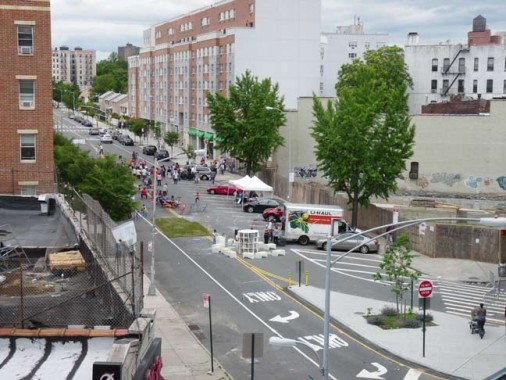
A view of Louis Niñé Boulevard, pronounced Nee-NYAY. It’s not named for Louis IX, a medieval king of France, but for an admired state assemblyman. Wilkins Avenue was renamed for him in 1985.
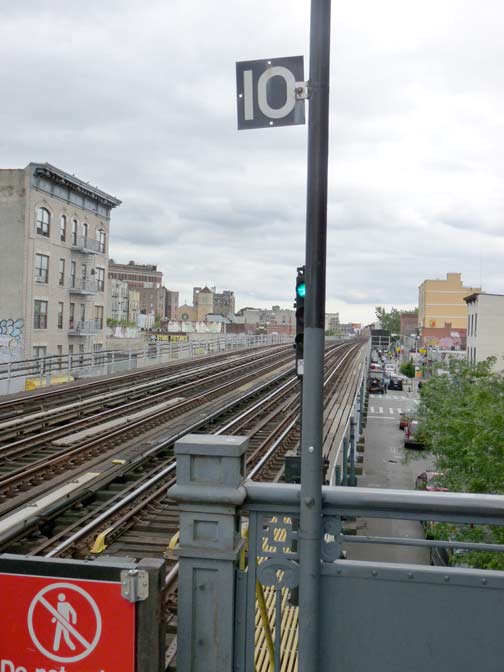
If anyone’s unaware what these boxed numbers found on train platforms are, they tell the motorman where to stop the train based on how many cars in his unit. 8’s and 10’s are mostly found, though on the Flushing Line you find 11’s, since that line uses 11-car units.
7/7/13

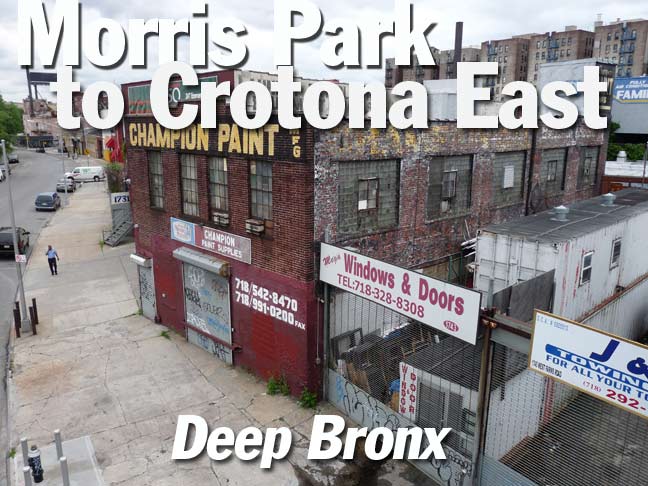
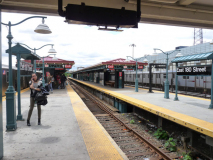
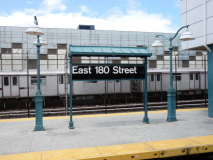
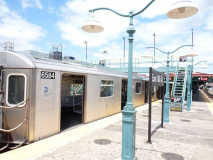
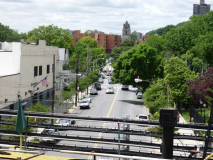
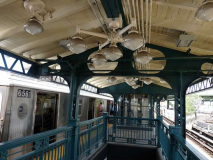
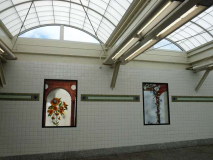
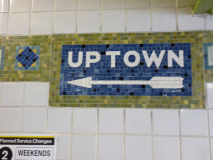
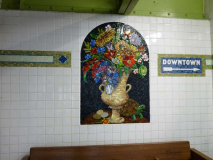
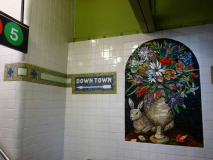
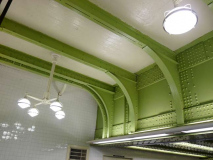
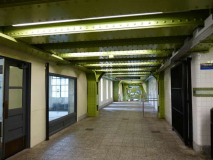
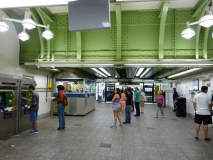
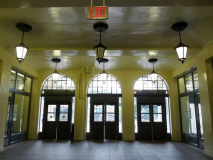
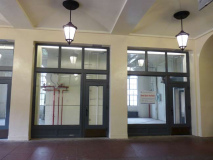
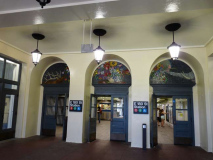
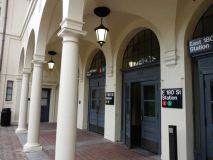
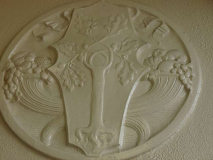
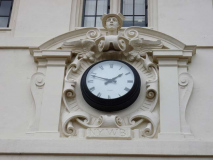
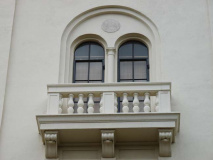
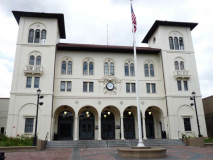
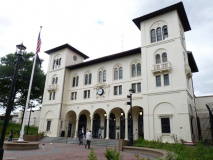
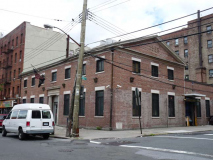
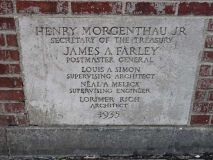

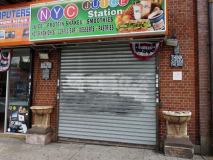
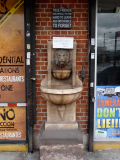
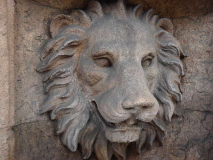
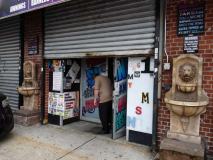
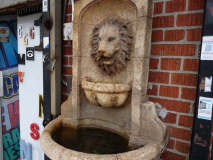
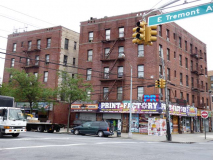
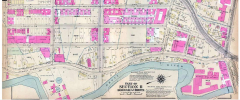
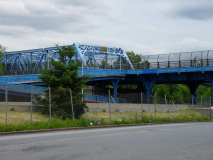
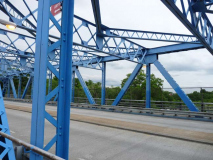
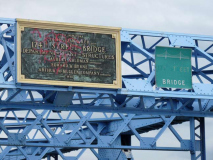
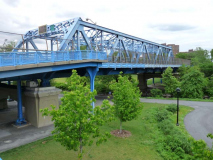
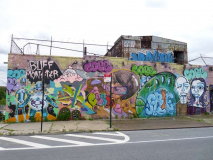
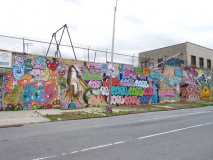


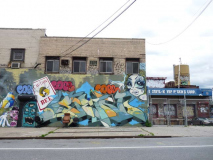

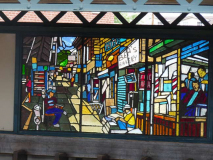
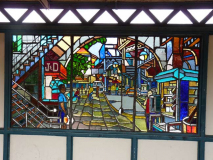
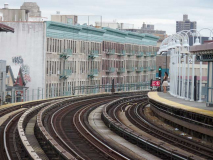
30 comments
wow 180 looks fabulous! I went through that station every day to school or work. Id smell bacon n eggs cooking in the little lunch counter to the right of the the entrance. there was a barber shop, a news stand and a tv repair shop. all gone when the mta cancelled the leases during phase one of improving conditions system wide in the 80’s. Interboro Fuel had a nice neon clock above the name for many years. where did that go. A bike path in starlight park? this are area was pretty dicey back in the day. don’t go alone. I used to bike on Boston rd. or Bruckner Blvd. to get to the city.
There was a newsstand/candy store in the E. 180th St. station house as recently as September of 2011. Gone now, of course.
wrote too much,didnt appear. Station looks unrecognizable since when I used to pass through. The vestibule just inside had a lunch counter, shoe repair, tv repair, and a newsstand. The smell of bacon and eggs from the luncheonette, wonderful. I hope the MTA keeps the building and surroundings in good repair.
The old Federal Building at 90 Church St. Manhattan is also the Farley Building. It has a large Post Office and also structurally withstood 9/11. I believe it was built in the ’30s.
Intervale Avenue was reconstructed in the 1980s after a serious fire damaged the crossunder, fare control area and part of the platform. They didn’t restore it to period appearance (as they have done with the other stations). Perhaps they will do so in the future.
Let me qualify the date above : fire was in March 1989; station did not re-open until the spring of 1992.
I spend a lot of time at 180th but have never been downstairs. Thanks for the peek. I use the 5 train or the shuttle thru here and have always stayed on the platforms. Methinks I shall have to go down there to check stuff out.
The reason Intervale Ave. station was not renovated like the others is that it was totally rebuilt in the 1990s, after a fire destroyed it in 1989.
Cope is one of the pioneering legends of the NYC graffiti scene.
Uhhh. Sorry. He was definitely “up” and made a name for himself in the early 80’s and beyond, but he is certainly NOT a pioneering legend in the NYC writing scene.
Let’s keep the “pioneering” tag for guys like Riff 170, Stay High 149, Phase 2, Super Kool 223, Staff 161, Tracy 168 and others who developed the culture way before guys like Cope came along almost ten years later.
None of these graffiti vermin could ever shine the shoes of true Bronx legends such as Colin Powell, the Chantels, Bill Graham, Bobby Darin, Ellen Barkin, Norman Fox & the Rob Roys, the Chords, Carl Reiner, Billy Joel, Robert Klein, Eyde Gorme, Bess Myerson … ad infinitum!
Bronx film history:
Van Nest was featured in “The 7 Ups” (1973)
West Farms appeared in “Marty” (1955)
Al’s Restaurant was on West Farms in the 60’s and probably for a long time before-good Italian food
475 Van Nest used to be a bocce club with a small bowling alley upstairs.In 1963 I started at Hunter College in the Bronx–in Spring of 1964 I joined Epsilon MU Chapter of Tau Epsilon Phi fraternity and at the time we rented the upstairs from the bocce club.It was the scene of many parties worthy of “Animal House”.
The last time the elevated along Southern Blvd. and Westchester Ave. last received a paint job was around 1983. Anybody can tell you that unpainted metal is not a good idea, especially with a structure like this. I scratch my head to figure out why the 2/5 train structure is allowed to corrode.
The term “motorman” is no longer in the MTA’s lexicon. It has been replaced by the sex-neutral term “train operator”. I should know. My daughter’s been one for about two months.
Congratulations, that’s a job with security!
Screw political correctness. So long as a “man” is piloting the EMU’s, then “motorman” it is ! Why do so many “men” get their panties in a wad for such a trivial matter ? I do not get this.
Now, now. What then would you call a woman who’s driving the train: “motorwoman”? (That sounds like a rejected superhero from the Marvel Universe.) It’s just as easy to have one term for everyone.
I’d only found out a few years ago about the fire at the Intervale station. I’d always wonder why it was listed on subway maps as “CLOSED” for so long.
The catenary tower in Starlight Park did not belong to the New Haven RR, but the New York, Westchester & Boston RR. It’s not too far from where the Westchester tracks veered away from the New Haven’s Harlem River branch, now Amtrak’s Hell Gate Route.
The railroad relic in the Starlight Park photo is a catenary wire bridge from the New York, Westchester & Boston Railway, not the New Haven. If you were located south of the structure and looking North, the New Haven and NYW&B diverged here, with the New Haven going toward the right and the NYW&B going toward the left. In person, look carefully at the base of this steel bridge and you will see new replacements of bolts and steel plate. Possibly an engineer determined that for safety reasons these parts needed to be replaced. So it is not 100% original.
Nice effort Kevin! Anyone else believe The Bronx’s time will come? For what people are paying to rent an apartment in Manhattan, LIC, Astoria, Hoboken, parts of Brooklyn, it seems like eventually more and more of the Bronx will start to gentrify. Those town house units look beautiful. A subway ride away from downtown Manhattan!
You Identify one of your images of a church at 475 Van Nest Ave, as being in a former multi-family home. It is in fact, located in what was the Van Nest Recreation Center. The Rec was on the first floor and for many years part of the second floor was occupied by the Italian American War Veterans.
I hope the new plan for West Farms and the Sheridan Expressway come to fruition. It will make life better for pedestrians and allow for better access to the park. Being that all those graffiti covered buildings are being demolished for new housing… it seems possible.
Great post, fascinating – but I think the street that was renamed Louis Nine Boulevard was Wilkins Avenue.
Fixed.
Wow, love all the history & especially that I lived in the Bronx from ages 6 to 10
I was at Instiutes of Applied Human Dynamics Day Habilitation center on 1680 Southern blvd in the bronx.
My family’s restuarant 1341 Wilkens Ave. 1962-1978. Apt. Building owners burnt down for insurance as much as they could. Including our store. The last big NYC black out was the final stray. Police saved Hunts Point, gave up Freeman st./ Wilkens Ave.
Oh yeah, Willie’s Sweet Shop on 1341 Wilkens Ave. We lived at 859 Jennings St. In what was the Rectory to a church on Wilkens Ave that burnt down in the ’30’s.